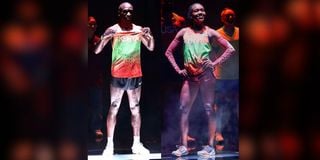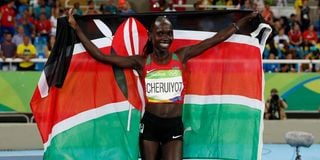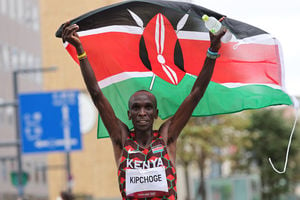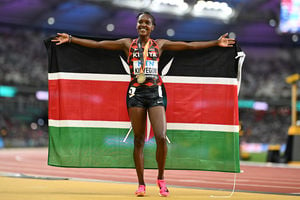
Kenya's Eliud Kipchoge and Faith Kipyegon models Team Kenya kit for 2024 Olympics in Paris on April 12, 2024.
Two Kenyan women, Thandiwe Muriu and Joy Richu, have within months captured the attention of the fashion and design world.
They have broken the glass ceiling for Kenyans in creative arts and advertising in the lead-up to the 2024 Paris Olympic Games.
Photographic artist Muriu was commissioned by World Rally Championship (WRC) points leader, Belgium Thierry Neuville, to design the colour scheme of his competition helmet through a global online competition.
The Belgian had been impressed by Muriu's Instagram page posts early this year.
The colour scheme was beautifully applied on the helmet that sold for £21,160 (Sh3,470,240) at Bonhams Cars Auction in Britain to raise money for charity including aiding a Kenyan school proposed by Muriu.

Joy Richu, the designer and illustrator behind innovative design for Coca-Cola's first-ever African-inspired drink- Wozzaah.
But it's Richu who has made it big time after cracking the highly competitive American creatives market. She is the force behind the innovative design for Coca Cola's first ever Africa- inspired beverage "Wozzah" limited edition Coke through visual storytelling.
The visuals capture an explosion of yellow and purple with touches of red on the can. One was gifted to President William Ruto during his visit to Coca Cola headquarters in Atlanta, Georgia, United States on May 21.
Richu and Muriu are like Kenyan songwriter and singer Sofia Nzau whose vocals in Mwaki song, which features the EDM hit by Brazilian music producer Zerb, sang at last year’s Las Vegas Formula One Grand Prix, and attracted rave reviews.
All these examples illustrate the creative ability of Kenyans. Little wonder Kenyans are already grumbling loudly on why, with such talent, the country can flop so badly in the colour choice and design of Team Kenya track suits and the varied green hues.
Now driven by the internet through platforms like TikTok, Instagram, Facebook and X, the Gen Z are wondering what to expect when the complete competition and training kit is unveiled next week if the track suits and shoes editions released on Monday are anything to go by.
A set of track suits in different shades of black and red -- unveiled by the national rugby team on their way to Team Kenya pre-games training venue in Miramas, France on Monday has set tongues wagging. It is flat and without an identity of Kenya as a country compared to previous editions.
It has been dismissed as drab, cheap looking and uninspiring for the revered and loved rugby macho men compared to that of the Americans and Canadians which have a touch of Versace and Gucci international fashion houses after being shared on the internet by their respective Olympic committees this week.
The Kenyan kit for 2024 Olympics comes hot on the heels of the much maligned honey comb red and black kit of the 2020 Tokyo Olympics. Nike came under fire the public who described the uniform as not a presentation of Kenya.
Nike, the official apparel supplier of the National Olympic Committee of Kenya (NOC-K) and Athletics Kenya (AK) since replacing Adidas in 1992, has released four shades of plain coloured track suits -- black, green and red -- which has been received with mixed feelings.
Many Kenyans on social media compared what Nike has made for Kenya against United States and Canada.
There is also very little semblance of the national flag colours, with too much green, and a hue nearing yellow than green or a hybrid of Uganda colours on the running prototype kit Eliud Kipchoge and Faith KIpyegon sported during the launch of various livery last April in Paris.
Many have complained that it does not distinguish Kenyans, and is not as eye-catching as previous editions, notably the colour scheme of 1992-2001 which was unmistakably Kenyan.
NOC-K secretary general Francis Mutuku hopes Kenyans will receive the kit positively unlike the public backlash of the 2021 line.
"Nike takes the functionality element of their products first and primarily the liking of the competitors, and in our considered view the Kenyan kits meets all the requirements of countries kitted by Nike," said Mutuku.
“The American company has a high quality control policy which applies across the board for all countries. They give every country the same quality,” the NOC-K secretary further said.
Mutuku revealed that the Nike designs do not undergo public participation and the contract does not stipulate that they do.
However, the American apparel manufacturer does take feedback from athletes into account when designing shoes and other running gear.

Kenya's Vivian Cheruiyot celebrates her victory in the women's 5,000m Final at the Rio 2016 Olympic Games on August 19, 2016.
The NOC-K official is disappointed with Kenyans especially designers who fail to take part in national ceremonial dress competition whenever the government advertises tenders on the same. Many designers have however complained that there is lack of transparency in this exercise.
"Athletes always complain that the Kenyan kit does not measure up to the quality of that made for the United States.
But Mutuku differed saying fashion was not static and there were a lot of factors taken into consideration. He cited the Tokyo kit which received much public bashing. "When we passed the public reaction to Nike, they told us to give it time," said Mutuku.
"The same uniform emerged as the most loved elsewhere in the world," said Mutuku but opinion remains divided.
American Rob Lotwis, who has been in charge of the Kenyan Nike account for close to 30 years was forced to come out to defend their design work on the Kenyan kit.

Kenya's Noah Ngeny celebrates victory in the 1,500m at the Sydney Olympic Games on September 29, 2000.
In an interview with Nation Sport during the Bathurst World Cross Country Championship in Australia last year, Lotwis said there was a lot of consideration taken into account when designing the Kenyan uniform.
He said that the Tokyo Olympics kit was designed inspired by Ferrari’s Formula One racing team.
Nike wanted people to see Kenyan athletes as a red Ferrari in motion and at standstill through performance and distinctive colour.
Ferrari is distinguished from the rest of the crowd by its blood-red colour, and speed of course.
But Kenyans feel that public participation and local input would bring out a better accepted kit, at least in the country.







